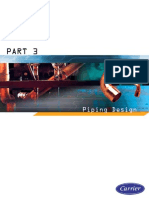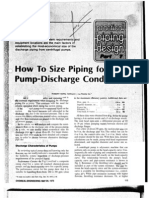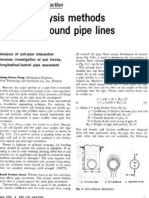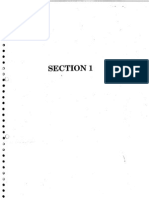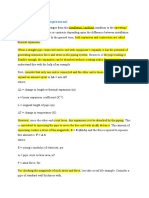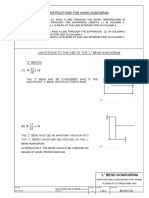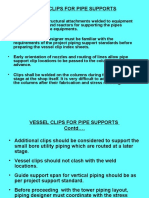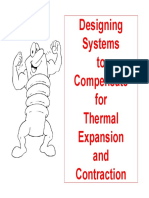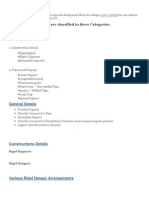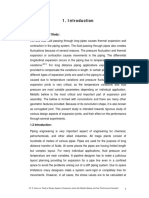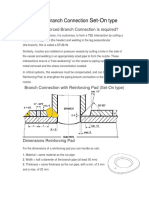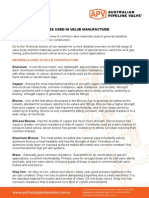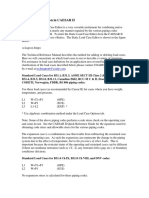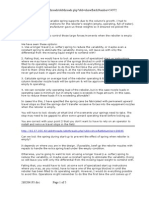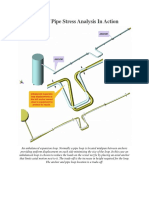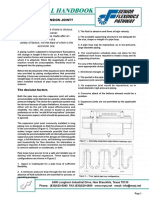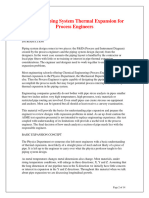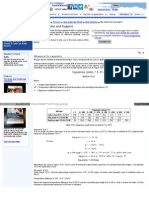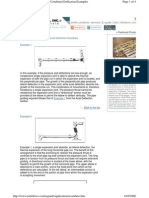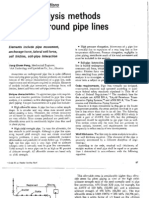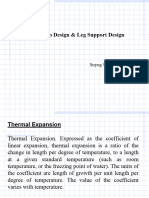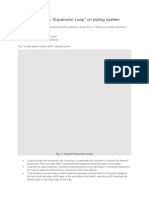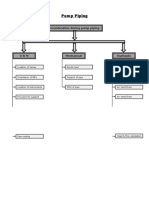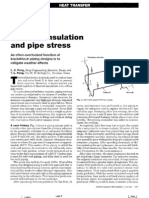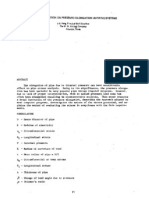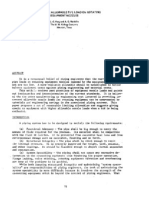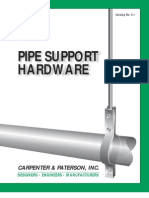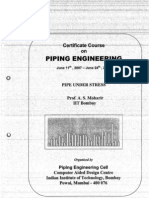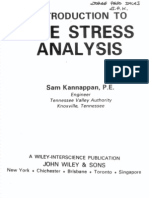Quick Check On Piping Flexibility
Quick Check On Piping Flexibility
Uploaded by
sateesh chandCopyright:
Available Formats
Quick Check On Piping Flexibility
Quick Check On Piping Flexibility
Uploaded by
sateesh chandOriginal Title
Copyright
Available Formats
Share this document
Did you find this document useful?
Is this content inappropriate?
Copyright:
Available Formats
Quick Check On Piping Flexibility
Quick Check On Piping Flexibility
Uploaded by
sateesh chandCopyright:
Available Formats
Quick Check on Piping Flexibility
L. C. Peng, PE
Peng Engineering, Houston, Texas
ABSTRACT
One major requirement in piping design is to provide adequate fl~xibility for absorbing the thermal expansion of the pipe. However, due to lack of quick method of checking, pipings are often laid-out to be either too stiff or too flexible. In either case, valuable time and material are wasted. This paper presents some of the quick methods for checking piping flexibility. These methods include visual, hand calculation, and micro computer approaches. They are all quick and easy for designers to use in planning their layouts. Once the designers have taken care of the flexibility problem, the iterative procedure between the stress engineers and the designers become simpler. The project schedule can also be improved.
PIPING FLEXIBILITY'
As the pipe temperature changes from the installation condition to the operating condition, it expands or contracts. In the general terml both expansion and contraction are called thermal expansion. When a pipe expands it has the potential of generating enormous force and stress in the system. However, if the piping is flexible enough, the expansion can be absorbed without creating undue force or stress. Providing the proper flexibility is one of the major tasks in the design of piping system.
Piping is used to convey a certain amonut of fluid from one point to another. It is obvious that the shorter the pipe is used the lesser the capital expenditure is required. The long pipe may also generate excessive pressure drop making it unsuitable for the proper operation. However, the direct shortest layout generally is not acceptable for absorbing the thermal expansion.
Figure 1 shows what will happen when a straight pipe is directly connected from one point to another. First, consider that only one end is conneoted and the other end is loose. The loose end will expands an amount equal to
~ := e L
However. since the other end is not loose, this expansion is to be absorbed by the piping. This is equivalent to squeezing the pipe to move the end back an ~ distance. This amount of squezzing creates a stress of the magnitude
S = E {.6.jL) = E e
1
~ E Where,
~ .--,
I _.J A ::: thermal expansion. in
I· L .1 41 .1 e ;;;; expansion rate, in/in
L ::: pipe length, in
~ S ::: axial stress, psi
r-F E ::: modulus of elasticity, psi
A ::: pipe cross section area, in2
F ::: axial faroe, lbs Figure 1
The force required to squeeze this amount is
F ::: AS::: A E e
Take a 6-inch standard wall carbon steel pipe for instance, an increase of temperature from 70F ambient to 300F operating creates an axial stress of 42300 psi and an axial force of 236000 Ibs in the pipe. These are excessive even though the temperature is only 300F. It is clear that the straight line direct layout is not acoeptable to most of the piping. Flexibility has to be provided.
EXPANSION LOOP
Piping flexibility are provided in many different ways. The tUrns and offsets needed for running the pipe from one point to another provides some flexibility by themself. This inherent flexibility mayor may nat be sufficient depending on the individual cases. Additional flexibility can be provided by adding expansion loops or expansion joints. In the straight line example discussed above. the stress can be reduced by a loop installed as shown in Figure 2 or by an expansion joint as shown in Figure 3.
The idea in Figure 2 is to provide some pipe perpendicular to the
direction of expansion. In this [1]
way when the pipe expands it bends\\ /"/,L.OOPl.£'IGTH
the loop leg first before transmi- ~ . .~
t t i ng an y load to th e anchor. 'I'h e =I::jr-------=~:.J ~-
longer the loop leg the lesser the ..., l-EXPANSfON
force will be created. The force created is inversely proportional to the cube of the loop length and the stress generated is roughly
inversely proportional to the square of the loop length. The loop sometimes can take considerably more space and piping than what is available, or economically justifiable. This is especially true for large high temperature low
pressure pipings. In this case the ::
better method is to use expansion J lEI §
joint. Expansion joints are more g
sophisticated than the pipe loops -t-------r----' ..... -r------1
~hich are just extra lengths of the same piping. For this and
Figure
2
Figure
3
2
other reasons, engineers tend to favor piping loops over expansion joints. However, expansion joints can be used effectively in many applications when they are properly designed. One of the 'major requirements in the design of expansion joint system is to install sufficient restraints for maintaining the stability. This article deals mainly the loop approach.
THE CRITICAL PATH
In designing a plant, the piping is generally routed or laid-out by the piping designers then checked by the stress engineers as shown in figure 4.
Piping Designer 1 Inexperienced)
Stress Engineer
Piping Designer (Experienced)
Layout Piping-l
Not
Check Stress
Too
Flexible
Flexible
Layout Piping-2
Layout Piping-2
If Works
No Revision
Slow, Long Schedule
Excessive Material
PROJECT
Figure 4
3
There is a marked difference in the layout done by the experienced and the inexperienced designers. The experienced designers know the importance of the flexibility. However, they tend to provide too much flexibility in contrast to the inexperienced ones who tend to provide little flexibility. In either case, the result is an over priced project.
The layout done by an inexperienced designer is normally too stiff because the designer docs not know how or too timid to add loops or offsets. If a piping system is too stiff, the stress engineer will almost certain to find it out. The stress engineer will send the design, with recommended loops, back to the designer for revision. At this time, the designer have made some more layouts in the same area making the revision very difficulty. On the other hand, a layout done by an experienoed designer often contains the loops whioh are excessive or not needed. The excessive loops are normally maintained without revision, becuase it is a common prctice not to change something which works. The experienced one might have saved the manhour needed for the revision. The cost of the excessive loops can be prohibitive.
The cost of the project can be reduced substantiallY if the right amount of flexibility is built in the piping at the initial layout stage. This requires some quick methods which can be used by the designers to check the piping flexibility.
VISUAL CHECK
The visual check is the first important examination on anything we do. If the design looks strange, then most likely something is wrong with it. By now we at least know that we can not run a piping straight from one point to another. This also applies to the situation when there are two or more line stops installed at a straight header as shown in Figure 5. The line stop or axial stop acts directly against the expansion of the pipe. When two axial stops installed on the same straight leg, the thermal expansion of the pipe located between the stops has no place to relieve.
Figure 5
The visual check of the piping flexibility is to look for the pipe legs located in the direction perpendicular to the line connecting the two anchor or other restraint points. The length of the leg IS
4
the direct measure of the flexibility. Therefore, the key is to locate the availability of the perpendicular leg and to determine if the length of the leg is sufficient. The required leg length can be estimated by the rule of thumb equation (1) derived by the guided cantilever approach, for steel pipes.
1 = 5.5 F
(1)
where,
l = leg length required, ft
D = pipe outside diameter, in
b = expansion to be absorbed, in
To use Equation (1) efficiently the expansion rate of the pipe has to be remembered. Table 1 shows the expansion rates of carbon and stainless steel pipes at several operating temperatures. The rate at other temperature can be estimated by proportion. By combining Equation 1 and Table 1, the designer can estimate the leg length required without needing a pencil. For instance, an 80 feet long 6-inch carbon steel pipe operating at 600F expands about 4 inches which requires a 30 feet leg to absorb it. It should be noted that an expansion loop is considered as two legs with each leg absorbs one half of the total expansion.
Table 1
Expansion Rate, in/lOa ft pipe
Temp,F 70 300 500 800 1000
Carbon Steel 0 1. 82 3.62 6.7 8.9
,
Stainless Steel a 2.61 5.01 8.8 11.5 HAND CALCULATION
There are several simplified calculations can be performed quickly with hand. The most popular one is the so called guided cantilever approach. The method can be explained using the L-bend given in Figure 6 as an example. When the system is not constrained the
_-
.ri B I
'o-----:E-ol c , ~ 1
A
A
8 8'
~------------~-l
I I I
C I ay:Y__, c'
~
(a) Free Expansion (b) Constrained Expansion
Figure 6
5
points Band C will move to B' and C' respectively due to thermal expansion. The end point C moves dx and dy respectively in X- and y- directions, but no internal force or stress will be generated. However, in the actual case the ends of the piping are always constrained as shown in Figure 6(b). This is equivalent in moving the free expanded end C' back to the original point C forcing the point B to move to 8". The dx is the expansion from leg AS, and dy from leg CB. The deformation of each leg Can be assumed to follow the guided cantilever shape. This is conservative because the end rotation is ignored. The force and stress of each leg can now be estimated by the guided cantilever formula. The leg AB is a guided cantilever subject to dy displacement and leg CB a guided cantilever subject to dx displacement respectively.
From the basic beam theory, the moment and displacement relation of a guided cantilever is
1'1 ::
2 M
.6 ,
F ::
(2 )
L
For thin wall pipes, Equation (2) can be further reduced. By using I::: It r:3 t and 8:::MI ( It ri! t), the above equation becomes
S :::
(3 )
where, S :: thermal expansion stress, psi
E ::: modulus of elasticity, psi
r :: mean radius of the pipe, in
f:,. :: total expansion to be absorbed, in
L :: length of the leg perpendicular to in
1.. :: length in feet unit, ft
D :: outside diameter of the pipe, in Equation (3) is a convenient formula for the quick estimation of the expansion stress. By pre-setting E::29.0xl0 psi and 8=20000 psi, Equation (3) becomes Equation (1) used in finding the leg length required for steel pipes.
The other formula oan be used for the quick check is the one given in ANSI B31 Piping Codes. The Code uses Equation (4) as a measure of adequate flexibility, sUbje6ts to other requirements of the Code.
D y
< 0.03
(<1 )
where, D :: outside diameter of the pipe, in
y :: resultant of total displacement to be absorbed, in
L :: developed length of' piping between anchors, ft
U = straight line distance between anchors, ft Equation (4) is actually equivalent to Equation 11), if IL-U) is considered as the perpendicular leg length.
6
Equation (4) has to be used with great care, because the same extra length of pipe can have very diferent effects depending on the ways the pipe is laid-out. Normally more flexibility will be achieved if the pipe is placed farther away from the elastical or geometrical center. For instance with the same extra length of piping, when it is laid-out as shown in Figure 7 (a) it has much higher flexibility than when it is laid-out as in Figure 7 (b). Designers often have the misconception about the amount of flexibility can be provided by the zig-zag arrangement. Due to the extra elbows placed in the layout, one tends to think that additional flexibility should have been created. Unfortunately, the additional flexibility from the elbows is not enough to compensate the loss of flexibility due to the placement of pipe toward the geometrical center.
24'
84' 1----=-----;°1 f
, /
GeOmetrica~~ Center l~
Geometrical Genter
i
1241
i I
I
6" ¢ 5T£), CS @ 500"P
,
(a) Stress = 13764 psi
(b) Stress = 8226 psi
Figure 7
MICRO COMPUTER APPROACH
C4'
j_
Current17 most large engineering companies use CAD system to do the piping design. It is possible that one day the system will be able to tell you if you need an7 extra flexibility, as soon as you place the line on the screen. However, before that time comes, we still have to Burvive the current situation to be able to see the good thing coming. Nevertheless, the technology of the micro computer has advanced enough for us to perform acourate flexibility analyses right beside the drafting board.
The micro computer programs are normally so user friendly that it takes only a couple of hours to master their usage. With respect to the flexibility check, a piping designer can do almost as good a job as a stress engineer can. What it is needed is to enter the pipe and geometrical information to the program which will almost instantly give you the forces and stresses expected in the system. From that information, the designer can then decide if additional loops or offsets are required.
The use of the micro computer differs SUbstantiallY depending on the individual program setup. Each program has its preferred method of entering the data and generating the output. Appendix A shows the sample operating procedure using PENG.QFLEX program to analyze the simple system liven in Figure 8.
7
TEA51/3iG LoOp LOCATIONS
Figure 8
Once it is determined that an expansion loop is required, the loop can be placed at one of the feasible locations before the area is congested by other layouts. This also saves the iterative process between the piping designers and the stress engineers.
CONCLUSION
The traditional piping design procedure depends heavily on the stress engineer to check piping flexibility. With the availability of quick methods in checking the flexibility, the designer can now layout the pipe to provide the proper flexibility at the very beginning. This substantially reduces the number of iterations required between the piping designer and the stress engineer. The cost of the plant can be reduoed by the shorter schedule and less manpower required.
You might also like
- Parte 3.-Piping Design Carrier HandBookDocument122 pagesParte 3.-Piping Design Carrier HandBookNestor Sanchez Villasmil100% (8)
- How To Size Piping For Pump-Discharge ConditionsDocument8 pagesHow To Size Piping For Pump-Discharge Conditionssateesh chand100% (6)
- How To Size Piping For Pump-Discharge ConditionsDocument8 pagesHow To Size Piping For Pump-Discharge Conditionssateesh chand100% (6)
- Stress Analysis Methods For Underground Pipe Lines Part 2 - Soil-Pipe InteractionDocument5 pagesStress Analysis Methods For Underground Pipe Lines Part 2 - Soil-Pipe Interactionsateesh chand100% (1)
- Pipe Stress Analysis SEMINAR COADEDocument463 pagesPipe Stress Analysis SEMINAR COADEmmahadary100% (2)
- How To Weld 254 SMODocument12 pagesHow To Weld 254 SMOsateesh chand100% (7)
- Piping Flexibility - Thermal Expansion in PipingDocument6 pagesPiping Flexibility - Thermal Expansion in PipingMohamed Al-Odat100% (1)
- Piping Flexibility CheckingDocument5 pagesPiping Flexibility Checkingeko123No ratings yet
- Pipe Expansion and Support - DeterminationDocument23 pagesPipe Expansion and Support - DeterminationGodwinNo ratings yet
- Piping Flexiblility CalculationDocument8 pagesPiping Flexiblility CalculationAntoshalNo ratings yet
- Expansion Loop Calculation 1665103990Document6 pagesExpansion Loop Calculation 1665103990Ponnaiah SathiyaprabhuNo ratings yet
- 436 Piping Course DescriptionDocument2 pages436 Piping Course DescriptionAnonymous q9eCZHMuS100% (1)
- SteelWise Specifying MaterialsDocument6 pagesSteelWise Specifying Materialsv100% (1)
- Accommodating Expansion in Piping SystemsDocument52 pagesAccommodating Expansion in Piping SystemsBeomHee LeeNo ratings yet
- Piping DesignDocument65 pagesPiping DesignShrey PatelNo ratings yet
- Expansion Joints How To Select and Maintain ThemDocument6 pagesExpansion Joints How To Select and Maintain ThemSeungmin PaekNo ratings yet
- Pipe SleeveDocument2 pagesPipe Sleevepaansaeng_hotmailNo ratings yet
- Pipe L Bend NomogramDocument4 pagesPipe L Bend NomogramPralesh12No ratings yet
- The in Uence of The Bourdon Effect On Pipe Elbow: September 2016Document11 pagesThe in Uence of The Bourdon Effect On Pipe Elbow: September 2016araz_1985No ratings yet
- Vessel Clips For Pipe Supports: - Vessel Clips Are Structural Attachments Welded To EquipmentDocument10 pagesVessel Clips For Pipe Supports: - Vessel Clips Are Structural Attachments Welded To EquipmentshaliniNo ratings yet
- Expansion Loops Antetsiz v2Document13 pagesExpansion Loops Antetsiz v2Aan DamaiNo ratings yet
- CSI Bolt-On Heating SystemsDocument12 pagesCSI Bolt-On Heating Systemspeubrandao100% (1)
- Thermal - Expansion and Expansion Loops, Z, and LsDocument99 pagesThermal - Expansion and Expansion Loops, Z, and LstylerstearnsNo ratings yet
- CAESAR II Software BasicsDocument28 pagesCAESAR II Software Basicsanishsr100% (1)
- Spring 1Document1 pageSpring 1tibor121774_66173108No ratings yet
- Expansion Loop Sizes For Steel PipeDocument1 pageExpansion Loop Sizes For Steel PipeArif FaturohmanNo ratings yet
- Implementation of Expansion LoopsDocument13 pagesImplementation of Expansion LoopsSSS100% (1)
- What Is A Wear Pad Functions of Pipe Wear PadsDocument3 pagesWhat Is A Wear Pad Functions of Pipe Wear PadsPrabhakar KumarNo ratings yet
- Definitions - Piping NotesDocument4 pagesDefinitions - Piping NotesMridul Das100% (1)
- DN24007E Rev. B - Flushing SpecificationDocument4 pagesDN24007E Rev. B - Flushing Specificationphankhoa83-1No ratings yet
- Application of Moment Restraining Supports in Process Plant Critical Piping-Full Paper-2019 PDFDocument5 pagesApplication of Moment Restraining Supports in Process Plant Critical Piping-Full Paper-2019 PDFPratip Bhattacharya100% (1)
- Section 230516 - Expansion Fittings and Loops For Hvac PipingDocument5 pagesSection 230516 - Expansion Fittings and Loops For Hvac PipingChase GietterNo ratings yet
- Jacketed Ball Valves LeafletDocument2 pagesJacketed Ball Valves LeafletSherif EltoukhiNo ratings yet
- Piping EnggDocument2 pagesPiping Enggashaikhimran7No ratings yet
- Piping Thickness Calculation With An ExampleDocument10 pagesPiping Thickness Calculation With An ExampleMahendran KuppusamyNo ratings yet
- Thermal Expansion in Piping SystemsDocument55 pagesThermal Expansion in Piping SystemsDivyaSheth100% (1)
- Different Ways To Create and Represent Jacketed Pipe LineDocument12 pagesDifferent Ways To Create and Represent Jacketed Pipe LineN NexusNo ratings yet
- Pipe SupportDocument6 pagesPipe SupportEshant Rane RaneNo ratings yet
- Points Which Should Be Incorporated While Making Flexibility SpecificationDocument2 pagesPoints Which Should Be Incorporated While Making Flexibility SpecificationtiwanasandyNo ratings yet
- Pipierack PlanDocument1 pagePipierack PlanpouyaNo ratings yet
- Asme 16.5Document2 pagesAsme 16.5Norman MoralesNo ratings yet
- PHD Thesis 10 Chapter1Document26 pagesPHD Thesis 10 Chapter1araz_1985No ratings yet
- Reinforced Branch Connection Set-On TypeDocument3 pagesReinforced Branch Connection Set-On Typeedgar paglinawanNo ratings yet
- Pipe Hangers, Pipe Supports, Variable and Constant Spring HangersDocument2 pagesPipe Hangers, Pipe Supports, Variable and Constant Spring Hangerskaiju85No ratings yet
- Standars Size&Fitting DimensionsDocument19 pagesStandars Size&Fitting DimensionsTran Anh TuanNo ratings yet
- Valve Material TypesDocument3 pagesValve Material TypesimanadbNo ratings yet
- Flanges - Composite Type: See Larger ImageDocument18 pagesFlanges - Composite Type: See Larger Imagemishaqazhar824No ratings yet
- Load Case Definition in CAESAR IIDocument8 pagesLoad Case Definition in CAESAR IINilesh Gohel100% (1)
- Reboiler DiscussionDocument5 pagesReboiler DiscussionlatshareNo ratings yet
- Piping ClassDocument2 pagesPiping ClassDylan RamasamyNo ratings yet
- Ball Valve - FlowtekDocument6 pagesBall Valve - Flowteknnaemeka omekeNo ratings yet
- Basics of Pipe For Oil & Gas EngineerDocument12 pagesBasics of Pipe For Oil & Gas EngineerMannuddin Khan100% (1)
- Screenshots of Pipe Stress Analysis in ActionDocument17 pagesScreenshots of Pipe Stress Analysis in ActionCepi Sindang Kamulan100% (3)
- Pipe Stress Training Course - SSUTADocument10 pagesPipe Stress Training Course - SSUTAalizadeh2222No ratings yet
- Aspect-96-155 Lateral Buckling PalmerDocument20 pagesAspect-96-155 Lateral Buckling PalmerJuan Roberto López Betanzos100% (2)
- TH10 - Pipe Loop or Expansion JointsDocument3 pagesTH10 - Pipe Loop or Expansion JointsloukatsNo ratings yet
- Pipe Expansion and SupportDocument11 pagesPipe Expansion and SupportLorenzoNo ratings yet
- Basics of Piping System Thermal Expansion For Process EngDocument12 pagesBasics of Piping System Thermal Expansion For Process EngAttalh Djaafar AttalhNo ratings yet
- WWW Spiraxsarco Com Resources Steam Engineering Tutorials ST 3Document12 pagesWWW Spiraxsarco Com Resources Steam Engineering Tutorials ST 3Mashudi FikriNo ratings yet
- (Ej Guide) : Lateral, Angular and Combined Deflection ExamplesDocument4 pages(Ej Guide) : Lateral, Angular and Combined Deflection ExamplesproxywarNo ratings yet
- Stress Analysis Methods For Underground Pipe Lines Part 1 - Basic CalculationsDocument5 pagesStress Analysis Methods For Underground Pipe Lines Part 1 - Basic Calculationskumaran__k100% (4)
- Expansion Loop DesignDocument61 pagesExpansion Loop DesignTauqueerAhmad100% (1)
- Basics of Piping System Thermal Expansion For Process EngineersDocument14 pagesBasics of Piping System Thermal Expansion For Process EngineersGoce VasilevskiNo ratings yet
- A Short Article OnDocument4 pagesA Short Article Onresamod288No ratings yet
- Steam Turbines A Book of Instruction for the Adjustment and Operation of the Principal Types of this Class of Prime MoversFrom EverandSteam Turbines A Book of Instruction for the Adjustment and Operation of the Principal Types of this Class of Prime MoversRating: 5 out of 5 stars5/5 (2)
- NPSHDocument7 pagesNPSHsateesh chand100% (1)
- Consideration During Pump PipingDocument4 pagesConsideration During Pump Pipingsateesh chand100% (1)
- DOE Fundamentals Handbook, Mechanical Science, Volume 1 of 2Document122 pagesDOE Fundamentals Handbook, Mechanical Science, Volume 1 of 2Bob VinesNo ratings yet
- DOE Mechanical Science Volume 2 of 2 DOE-HDBK-10182-93Document130 pagesDOE Mechanical Science Volume 2 of 2 DOE-HDBK-10182-93Titer100% (1)
- Thermal Insulation and Pipe StressDocument3 pagesThermal Insulation and Pipe StressDevin KendrickNo ratings yet
- Evaluating Dynamic Stresses of A PipelineDocument8 pagesEvaluating Dynamic Stresses of A PipelinejasminNo ratings yet
- Stress AnalysisDocument6 pagesStress Analysisapi-3836286100% (4)
- Richmond Stress NotesDocument110 pagesRichmond Stress Notessateesh chand100% (2)
- Treatment of Support Friction in Pipe Stress AnalysisDocument6 pagesTreatment of Support Friction in Pipe Stress Analysissateesh chandNo ratings yet
- Pressure Elongation in Piping Systems - L PengDocument8 pagesPressure Elongation in Piping Systems - L PengmkstngrNo ratings yet
- Stress Analysis Methods For Underground Pipe Lines Part 1 - Basic CalculationsDocument5 pagesStress Analysis Methods For Underground Pipe Lines Part 1 - Basic Calculationskumaran__k100% (4)
- Rethinking The Allowable Pipe Load On Rotating Equipment NozzlesDocument12 pagesRethinking The Allowable Pipe Load On Rotating Equipment Nozzlessateesh chandNo ratings yet
- Static & Dynamic Analysis of Piping SystemDocument105 pagesStatic & Dynamic Analysis of Piping Systemkarthikeashwar100% (4)
- Cold Spring of Restrained Piping SystemDocument5 pagesCold Spring of Restrained Piping Systemsateesh chandNo ratings yet
- Quick Check On Piping FlexibilityDocument8 pagesQuick Check On Piping Flexibilitysateesh chandNo ratings yet
- Carpenter & Patterson Pipe HangersDocument164 pagesCarpenter & Patterson Pipe HangersRobert JaszekNo ratings yet
- Evaluating Dynamic Stresses of A PipelineDocument8 pagesEvaluating Dynamic Stresses of A PipelinejasminNo ratings yet
- Pipe Under StressDocument14 pagesPipe Under Stressvaldio84100% (1)
- Piping - Introduction To Pipe Stress AnalysisDocument129 pagesPiping - Introduction To Pipe Stress AnalysisNishith94% (18)
- Computer Application To The Piping Analysis Requirements of ASME Section III, Subscribe NB-3600Document12 pagesComputer Application To The Piping Analysis Requirements of ASME Section III, Subscribe NB-3600sateesh chandNo ratings yet
- WRC107 297Document4 pagesWRC107 297enjoygurujiNo ratings yet
- AVESTA POLARIT - Stainless Steels - Their Properties and Their Suitability For WeldingDocument11 pagesAVESTA POLARIT - Stainless Steels - Their Properties and Their Suitability For Weldingmirza_adil99No ratings yet
- Tabla de Referencia de Materiales: Material Reference ChartDocument2 pagesTabla de Referencia de Materiales: Material Reference Chartsateesh chandNo ratings yet
- NIDI - StainlessSteels and Specialty Alloys For Modern Pulp and Paper Mills - 11025Document152 pagesNIDI - StainlessSteels and Specialty Alloys For Modern Pulp and Paper Mills - 11025srtools1980yNo ratings yet
- ASTM A-358 With ClassDocument2 pagesASTM A-358 With Classsateesh chand100% (1)
